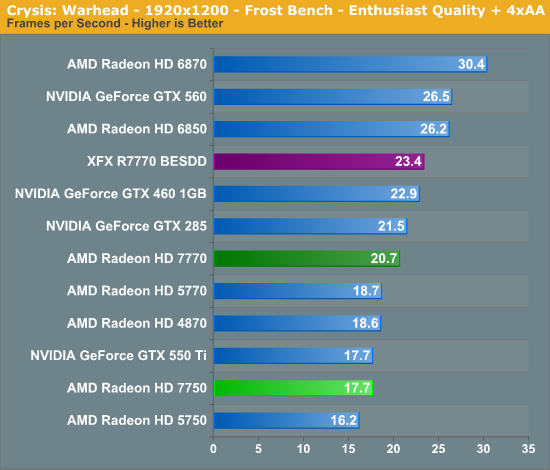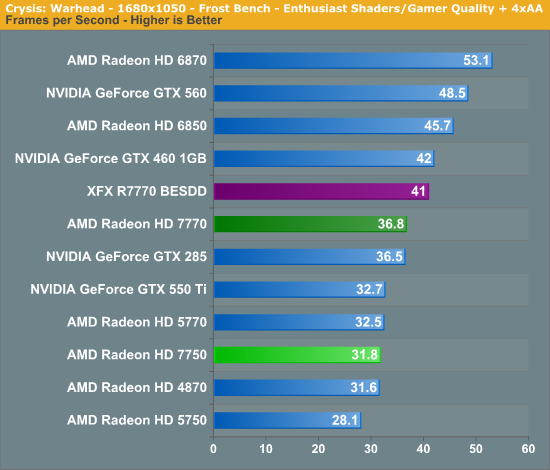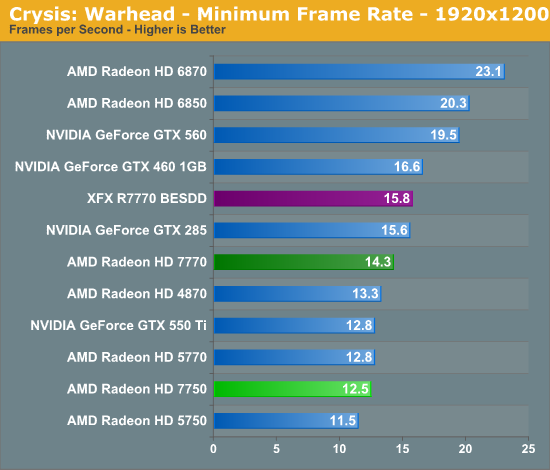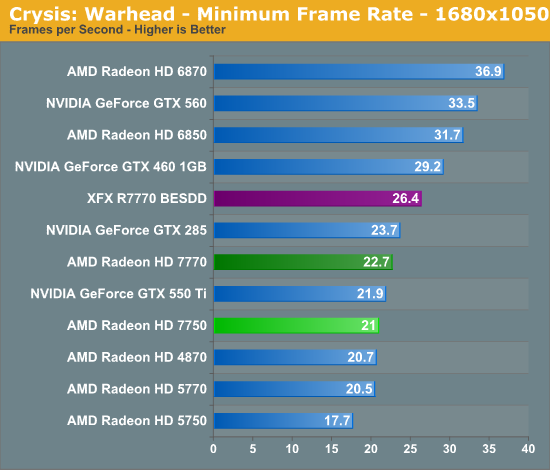AMD Radeon HD 7750 & Radeon HD 7770 GHz Edition Review: Evading The Price/Performance Curve
by Ryan Smith & Ganesh T S on February 15, 2012 12:01 AM EST- Posted in
- GPUs
- AMD
- HTPC
- GCN
- Radeon HD 7000
Crysis: Warhead
Kicking things off as always is Crysis: Warhead. It’s no longer the toughest game in our benchmark suite, but it’s still a technically complex game that has proven to be a very consistent benchmark. Thus even four years since the release of the original Crysis, “but can it run Crysis?” is still an important question, and the answer continues to be “no.” While we’re closer than ever, full Enthusiast settings at a 60fps is still beyond the grasp of a single-GPU card.


With AMD’s GCN architecture, Crysis is finally losing some of its predictive power, but it’s still a good indicator of overall performance. And the indicators aren’t very good.
From a price/performance perspective the 7700 needs to beat at least the 6850 on the AMD side and at least the GTX 560 on the NVIDIA side in order to ensure a clear-cut victory. Unfortunately it’s falling well short of that, underperforming the 6850 by 20% never mind the GTX 560. On paper the 7770 is outgunned on everything from texture performance to ROP performance to shader performance, so take your pick on what’s holding back Crysis performance, but the end result is that it’s well behind its previous-generation peers. In fact it’s closer to the 2.5 year old 5770 than it is the 6850.
As for the 7750, things are a bit better. In spite of its massive texture and shader deficit compared to the 7770, it’s only behind by 15%, offering some strong support that the actual performance difference between the two cards won’t be nearly as big as it is on paper. That said, on a price/performance basis it should be able to beat the 5770, and it isn’t quite there. But as the only card here that’s sub -75W, it has other favorable attributes.
Elsewhere XFX’s R7770 BESDD shows us that 7770 performance scales well with clockspeeds, with a 12% core overclock netting 11% better performance. This is a good sign for overclockers, but for factory overclocked cards it’s a mixed bag, as the higher price these cards fetch only puts them more in competition with the 6870.


The story of minimum framerates is much the same. The 7700 series continues to underperform its last-generation competition by quite a bit, and unfortunately we’re still several frames per second away from being able to sustain 30fps+ in Crysis at 1680.










155 Comments
View All Comments
tipoo - Wednesday, February 15, 2012 - link
I probably won't be enticed into a video card upgrade until the next generation of Microsoft and Sony consoles are out. In the land of console ports, even a 6770 can run nearly everything comfortably at most common monitor resolutions.Movieman420 - Wednesday, February 15, 2012 - link
I have an OCd C2D Wolfdale running the 4850 and I also agree that the 4850 will go down as one of the best bang for the buck cards ever.My current i5/Z68 rig is running what I think will be considered another BBFTB card...the 6850...the dual fan Gigabyte 685OC in my case.
The 5770/6770/7770 are a fantastic line of mid-range cards...esp OCd but for a few $$ more an OCd 6850 still holds it's own quite well, there's no real counter for a 256bit vs 128bit memory bus. A big hats off tho to the 7770's high res numbers...pretty damn sweet, but I don't need uber res for a 23.5 inch monitor...ofc I'm not a hard core gamer either.
cjs150 - Wednesday, February 15, 2012 - link
7750 seems perfect for an HTPC. But to put it into context, IGPs should be using the 7750 as the benchmark for what to aim for. Can see this becoming completely obselete very soon once products based on Raspberry pi or Cu Box get released and match (the very impressive) picture quality of the 7750. In mean time get a low profile passive cooled version out and it will be perfect.As for the 7770 I simply see no purpose for it at all. NVidia 560 is only marginally more expensive and beats it completely. 7770 seems to me to be a complete waste of stock
Shadowmaster625 - Wednesday, February 15, 2012 - link
So the 7770 should be at $109, and that forces the 7750 down to $89 or less. The die sizes on these chips are a lot smaller than their competition so I dont see what AMD is thinking. Inflation? lol.Shadowmaster625 - Wednesday, February 15, 2012 - link
Why would a 7750 consumer 3 watts less than a 7770 during the "long idle" state. That really makes no sense. During that state there shouldnt be any difference at all between the two cards.tipoo - Wednesday, February 15, 2012 - link
It has over 100 more stream processors? 3W is pretty minuscule.akbo - Wednesday, February 15, 2012 - link
They are using a gorram 1200W PSU and those have s*** efficiency at 10% load. 3 watts means that it may pull about 1 watt more on-chip.KompuKare - Wednesday, February 15, 2012 - link
Which begs a simple question that has been bothering me with Anandtech GPU reviews for a while: how come they don't measure the wattage for the cards rather the whole system. Ok, it needs a custom PCI-E riser board and a multimeter but other sites (like techpowerup.com or this French site (can't think of it ATM) where the place I first saw that method used) manage it.Or at a minimum why is there no IGPU (Intel 3000) power usage in the review to act as a baseline?
Death666Angel - Wednesday, February 15, 2012 - link
I'm kinda disappointed by the 77xx launch. I'd have hoped for some €150 - €200 cards, consequently performing better than the 6870. Maybe the 78xx will be better. I really hope nVidia comes around with good cards, that way the consumer won't get ripped off. Although I also hope that AMD makes some money in the mean time.geniekid - Wednesday, February 15, 2012 - link
I just want to reiterate how much I appreciate the games you've chosen for your benchmarks. It's a very diverse set of games and covers a lot of the non-FPS genres that other review sites tend to leave out.